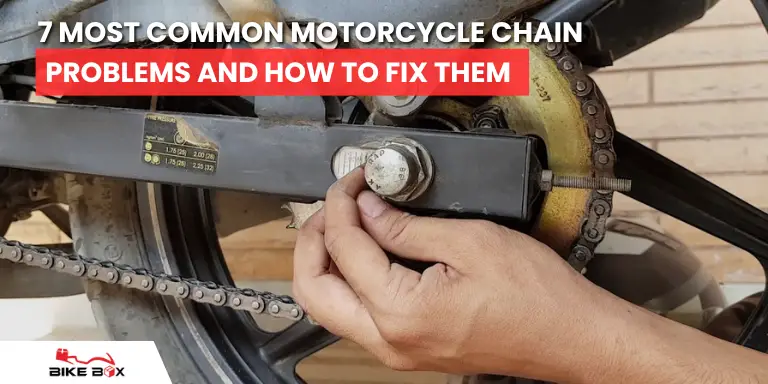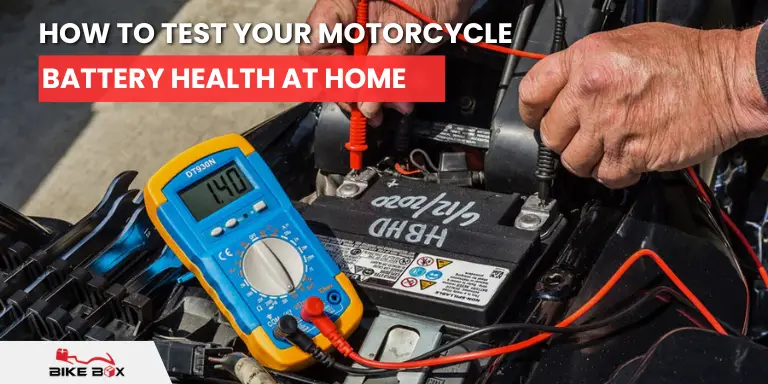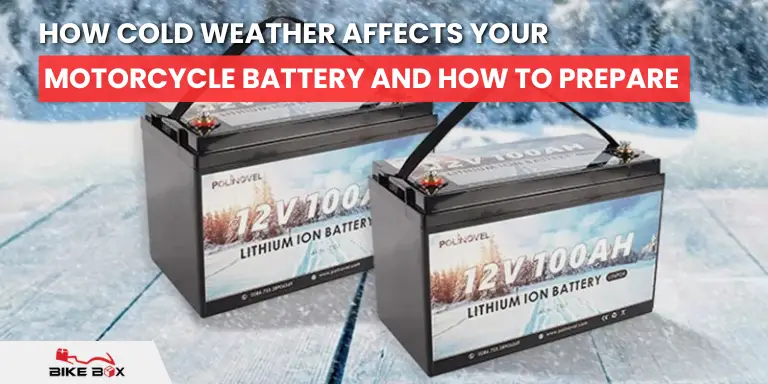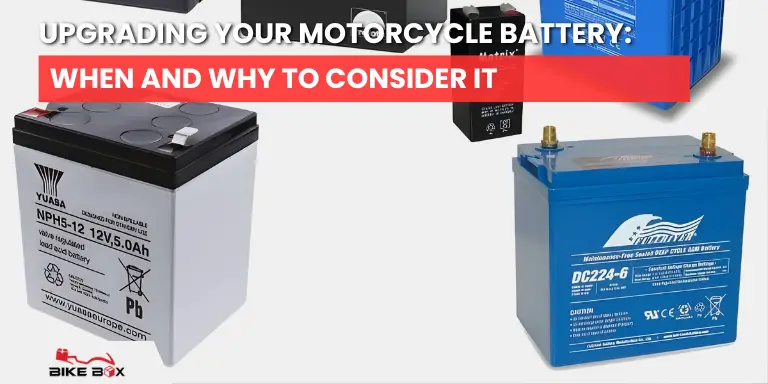Riding a motorcycle feels amazing: fast, smooth, and fun. But if your chain acts up, that feeling disappears. The chain is a small part. But it does a big job. If it goes wrong, your whole ride suffers. New rider or pro, it doesn’t matter. Taking care of your chain is a must.
In this blog, we’ll guide you through the 7 most common motorcycle chain problems and how to fix them. We’ll keep it simple. For a deeper look at performance, maintenance, and upgrade options, check out our complete guide to motorcycle chains and sprockets.
Also, if you’re looking for top-quality spare parts, Bikebox is the best choice. We offer reliable gear for chain care and more.
1. Loose Motorcycle Chain
A loose chain slaps around. It can jump off the sprocket. That can cause damage. Maybe even injury. Loose chains wear out faster. They feel sloppy on your ride.
Signs:
- The chain hangs lower than usual.
- You hear a loud thump or slap.
- Performance feels off.
Why does it happen?
- Dirt builds up in the Slack.
- Tension wasn’t set right after cleaning.
- Normal wear over time.
2. Tight or Over‑Tensioned Chain
Too tight is as bad as too loose. Over‑tensioned chains strain sprockets. They reduce shock absorption. You feel stiffer rides. And you’ll burn parts faster.
Signs:
- Hard to pedal or ride.
- Engine stutters or lurches.
- The chain shows no Slack when on the center stand.
Why does it happen?
- Over‑tightening during maintenance.
- The stretch in the chain was mis‑measured.
- Ignoring the manufacturer’s specs.
3. Motorcycle Chain Noise
Chains should hum quietly. No screeching. No clanking. No squeaking. Noise signals trouble. It means something’s wrong. Your bike needs attention.
Signs:
- Squeaking like a rusty metal joint.
- Grinding or metallic rattles.
- Clicking when turning.
Why does it happen?
- Dry chain needs lube.
- Worn parts scrape together.
- Dirt or grit trapped in the links.
4. Rusty Motorcycle Chain
Rust is a chain’s worst enemy. It weakens links. It saps smooth motion. Rust can spiral into full failure. Fix it fast.
Signs:
- Reddish-brown patches.
- Stiff movement.
- Bristles of rust when you clean.
Why does it happen?
- Rain or salt exposure.
- Infrequent cleaning.
- Storage in humid places.
5. Worn‑Out Sprockets
Chains don’t fail alone. Sprockets wear too. Sharp “shark‑fin” teeth appear. They slip. Chain alignment fails. New chain on old sprockets? Bad idea.
Signs:
- Teeth look hooked or thin.
- Chain lifts off under load.
- Skip or chatter during acceleration.
Why does it happen?
- Normal use.
- Skipping maintenance.
- Running the wrong chain type or no lubrication.
6. Chain Skipping or Slipping
When you twist the throttle, the chain should pull. If it slips, it’s scary. You lose traction. You lose control.
Signs:
- Sudden jerks in the drive.
- The chain pops off the sprocket under load.
- Skips at one or more teeth.
Why does it happen?
- Worn chain or sprockets.
- Too much Slack.
- Misaligned components.
7. Broken or Snapped Chain
This is the worst-case. Chain breaks mid‑ride, or worse, snaps under speed. That’s dangerous. You need to fix it now.
Signs:
- The chain hangs open.
- Bike coasts without a drive.
- Pieces scattered on the road.
Why does it happen?
- Extreme wear.
- Rust weakens links.
- Over‑tension or poor quality parts.
How to Fix Motorcycle Chain Problems (Step‑by‑Step)
Follow these steps. Ride safer. Love your bike more.
Step 1: Look Over the Chain and Sprockets
Get a clean rag and decent light. Look over each link. Look at every tooth. Catch the wear early.
Step 2: Clean Your Chain
Use a chain cleaner or kerosene. Brush with a soft brush. Get grime out of tight spots. Dry with a towel.
Step 3: Lubricate the Chain for Better Performance
Use chain lube. Apply drop by drop inside the rollers. Spin the wheel. Let the oil penetrate. Wipe excess.
Step 4: Replace if Needed
If links are stiff or sprockets look sharp, replace them. Don’t mix new chain with old sprockets. Replace as a set when possible.
Step 5: Realign
Use alignment marks on your swingarm. Keep the chain straight on the sprockets. Misalignment kills parts fast.
Step 6: Final Check
Spin wheels. Listen and look. The chain should move smoothly. No skipping. No noise. No rust.
Step 7: Ride and Re-Check
For more tips on cleaning, lubing, and adjusting your chain properly, learn the complete process to maintain your motorcycle chain.
Ride Smooth, Stay Safe: Fix Your Chain Before It Fails
Chain problems are common. But they’re fixable. You just need to act. Is the chain loose? Too tight? Noisy or rusty? Worn out or slipping? Find the problem. Then clean it. Tighten or loosen it. Add lube. Line it up. Replace it if needed.
Do it right. Ride safe. Keep that chain singing smooth tunes.
Need spare parts for your bike? Looking for a chain gear? Want a trusted motorcycle spare parts supplier? Bikebox is here for you. We offer trusted spares, fast shipping, and great prices.
FAQs
What causes a motorcycle chain to become loose?
Chains get loose over time. This happens because of inadequate care or wrong tension after cleaning. Checking them often can stop Slack. This keeps rides smooth and safe.
What are the signs that my motorcycle chain needs replacing?
Check for stiff links or rust. See if the chain won’t stay tight. If it skips, makes noise, or doesn’t fit right on the sprockets, replace it.
Can I ride with a noisy motorcycle chain?
A noisy chain means it’s dry, dirty, or misaligned. Riding is possible, but it’s unsafe. Ignoring the noise can cause big damage or a dangerous failure.
What can go wrong if the motorcycle chain is too tight?
A chain that’s too tight puts stress on sprockets, bearings, and transmission. This causes stiff rides, faster wear, and parts can break.
Why does my motorcycle chain keep slipping off?
Chain slipping means worn sprockets, bad alignment, or too much Slack. Fix it fast. Riding with a slipping chain is dangerous.




